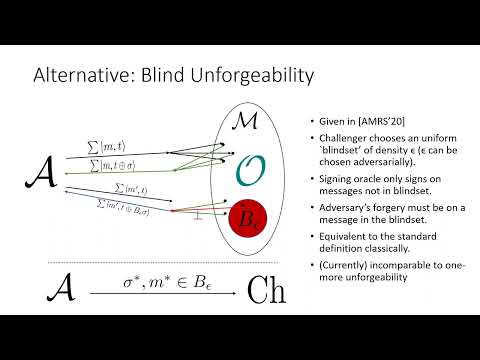CryptoDB
A Note on the Post-Quantum Security of (Ring) Signatures
| Authors: |
|
|---|---|
| Download: | |
| Conference: | PKC 2022 |
| Abstract: | This work revisits the security of classical signatures and ring signatures in a quantum world. For (ordinary) signatures, we focus on the arguably preferable security notion of {\em blind-unforgeability} recently proposed by Alagic et al.\ (Eurocrypt'20). We present two {\em short} signature schemes achieving this notion: one is in the quantum random oracle model, assuming quantum hardness of SIS; and the other is in the plain model, assuming quantum hardness of LWE with super-polynomial modulus. Prior to this work, the only known blind-unforgeable schemes are Lamport's one-time signature and the Winternitz one-time signature, and both of them are in the quantum random oracle model. For ring signatures, the recent work by Chatterjee et al.\ (Crypto'21) proposes a definition trying to capture adversaries with quantum access to the signer. However, it is unclear if their definition, when restricted to the classical world, is as strong as the standard security notion for ring signatures. They also present a construction that only {\em partially} achieves (even) this seeming weak definition, in the sense that the adversary can only conduct superposition attacks over the messages, but not the rings. We propose a new definition that does not suffer from the above issue. Our definition is an analog to the blind-unforgeability in the ring signature setting. Moreover, assuming the quantum hardness of LWE, we construct a compiler converting any blind-unforgeable (ordinary) signatures to a ring signature satisfying our definition. |
Video from PKC 2022
BibTeX
@inproceedings{pkc-2022-31824,
title={A Note on the Post-Quantum Security of (Ring) Signatures},
publisher={Springer-Verlag},
author={Rohit Chatterjee and Kai-Min Chung and Xiao Liang and Giulio Malavolta},
year=2022
}

